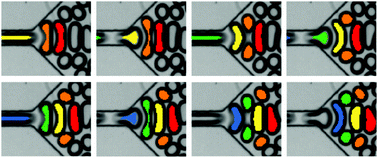Bubble–bubble pinch-off in symmetric and asymmetric microfluidic expansion channels for ordered foam generation†
Abstract
By incorporating the techniques of geometrically mediated splitting and bubble–bubble breakup, the present work offers a novel microfluidic foam generation system via production of segregated, mono- or bidisperse bubbles at capacities exceeding 10 000 bubbles per second. Bubble–bubble pinch-off is precise at high capillary numbers (Ca > 0.065), generating monodisperse or bidisperse daughter bubbles for a symmetric or an asymmetric expansion respectively. Bi- or tridisperse foam is produced as pinch-off perfectly alternates such that the system contains twice the number of fragmented bubbles as intact bubbles. A relationship between the upstream bubble extension and the capillary number demarcates the different regimes of pinch-off defined with respect to frequency and precision: non-splitting, irregular, polydisperse, and monodisperse (or bidisperse for an asymmetric expansion). For tridisperse foam generation via a fixed asymmetric expansion geometry, the wall bubble confinement can be tuned to adjust the pinch-off accuracy in order to access a spectrum of fragmented bubble size ratios. The simplicity in operating and characterizing our system will enable studies on dynamic bubble interactions and ordered, wet foam applications.



 Please wait while we load your content...
Please wait while we load your content...
